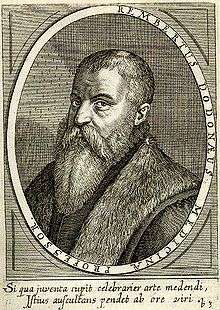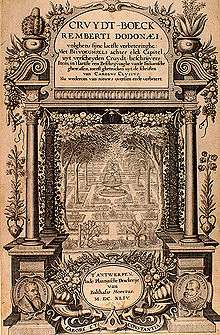Rembert Dodoens
| Rembert Dodoens | |
|---|---|
 Rembert Dodoens | |
| Born |
29 June 1517 Mechelen |
| Died |
10 March 1585 (aged 67) Leyden |
| Occupation | physician and botanist |
| Spouse(s) | Kathelijne de Bruyn(e) |
Rembert Dodoens (29 June 1517 – 10 March 1585) was a Flemish physician and botanist, also known under his Latinized name Rembertus Dodonaeus.
Biography
Dodoens was born in Mechelen. In 1530 he began his studies in medicine, cosmography and geography at the University of Leuven, where he graduated in 1535. He established himself as a physician in Mechelen in 1538. He married Kathelijne De Bruyn(e) in 1539. He had a short stay in Basel (1542–1546). He turned down a chair at the University of Leuven in 1557. He equally turned down an offer to become court physician of king Philip II of Spain. He became the court physician of the Austrian emperor Rudolph II in Vienna (1575–1578). He then became professor in medicine at the University of Leiden in 1582, and remained there until his death.
Dodoens' herbal Cruydeboeck (herb book) with 715 images (1554, 1563) was influenced by that of Leonhart Fuchs. He divided the plant kingdom in six groups. It treated in detail especially the medicinal herbs, which made this work, in the eyes of many, a pharmacopoeia.
It was translated first into French in 1557 by Charles de L'Ecluse (Histoire des Plantes), into English (via L'Ecluse) in 1578 by Henry Lyte (A new herbal, or historie of plants), and later into Latin in 1583. In his times, it was the most translated book after the Bible. It became a work of worldwide renown, used as a reference book for two centuries.[1]
Dodoens's last book, Stirpium historiae pemptades sex (1583) was the Latin translation of his Cruydeboeck. It was used as a source by John Gerard for his Herball.
Dodoens is commemorated in the plant genus Dodonaea, which was named after him by Carl Linnaeus.

Selected works
- Herbarium (1533)
- Den Nieuwen Herbarius (1543)
- Cosmographica in astronomiam et geographiam isagoge (1548)
- De frugum historia (1552)
- Trium priorum de stirpium historia commentariorum imagines (1553)
- Posteriorum trium de stirpium historia commentariorum imagines (1554)
- Crvyd-boeck (in Latin, Dutch) (1554, 1563)
- Historia frumentorum, leguminum, palustrium et aquatilium herbarum acceorum, quae eo pertinent (1569)[2]
- Physiologices medicinae tabulae (1580)
- Medicinalium observationum exempla rara (1581)
- Dodonaei, Remberti (1583) [1554]. Stirpium historiae pemptades sex, sive libri XXX [Crvyd-boeck] (in Latin). Antwerp: Plantini.
Posthumous
- Praxis medica (1616)
- Remberti Dodonaei Mechilensis ... stirpium historiae pemptades sex, sive libri XXX : varie ab Auctore, paullo ante Mortem, aucti & emendati. Antverpiae : Moretus / Plantin, 1616 Digital edition of the University and State Library Düsseldorf.
- Ars medica, ofte ghenees-kunst (1624)
References
- ↑ "Rembert Dodoens: iets over zijn leven en werk – Dodoens' werken". Plantaardigheden – Project Rembert Dodoens (Rembertus Dodonaeus) (in Dutch). Stichting Kruidenhoeve/Plantaardigheden, Balkbrug, the Netherlands. 20 December 2005. Retrieved 17 May 2007.
... het Cruijdeboeck, dat in 1554 verscheen. Dit meesterwerk was na de bijbel in die tijd het meest vertaalde boek. Het werd gedurende meer dan een eeuw steeds weer heruitgegeven en gedurende meer dan twee eeuwen was het het meest gebruikte handboek over kruiden in West-Europa. Het is een werk van wereldfaam en grote wetenschappelijke waarde. De nieuwe gedachten die Dodoens erin neerlegde, werden de bouwstenen voor de botanici en medici van latere generaties. (... the Cruijdeboeck, published in 1554. This masterpiece was, after the bible, the most translated book in that time. It continued to be republished for more than a century and for more than two centuries it was the mostly used referential about herbs. It is a work with world fame and great scientific value. The new thoughts written down by Dodoens, became the building bricks for botanists and physicians of later generations.)
- ↑ Pieter van der Borcht (I) made 60 drawings of plants for this herbarium that was published by Christopher Plantin in Antwerp
- ↑ IPNI. Dodoens.
Bibliography
- Pavord, Anna (2005). The naming of names the search for order in the world of plants. New York: Bloomsbury. ISBN 9781596919655.
- Vande Walle, W.F., ed. (2001). Dodonæus in Japan: translation and the scientific mind in the Tokugawa period. Leuven: Leuven University Press. ISBN 9789058671790.
External links
| Wikimedia Commons has media related to Rembert Dodoens. |
- Project Dodoens: concise biography, complete bibliography (linking to scans) - in English
- Project Dodoens: linking to comprehensive biography, complete bibliography (linking to scans), etc. - commentary in Dutch
- Cruijdeboeck, ed. 1554 (1st edition), illustrated, hand-colored - Complete 877 pages' scans online
- ed. 1563 (2nd edition)
- Cruydt-Boeck , ed. 1644 (posthumous, last and most comprehensive edition, illustrated)
(Cruijdeboeck, 13th ed.; 5th and last Flemish ed., 3rd ed. of the 1608 Cruydt-Boeck) - Complete 1588 pages' scans online - A new herbal, or historie of plants, ed. 1619 (5th, revised edition, no illustrations of plants):
the Cruijdeboeck in English translation by Henry Lyte,
based on the French Histoire des plantes ed. 1557, and the 2nd Flemish edition 1563 - Complete 627 pages' scans online
- Dodonæus in Japan - (pdf) - in English
- Image of Dodoens
- Extensive link collection of old herbals on the internet - commentary in Dutch.
- Online Galleries, History of Science Collections, University of Oklahoma Libraries High resolution images of works by and/or portraits of Rembert Dodoens in .jpg and .tiff format.
- Environmental History of the Rhine Meuse Delta